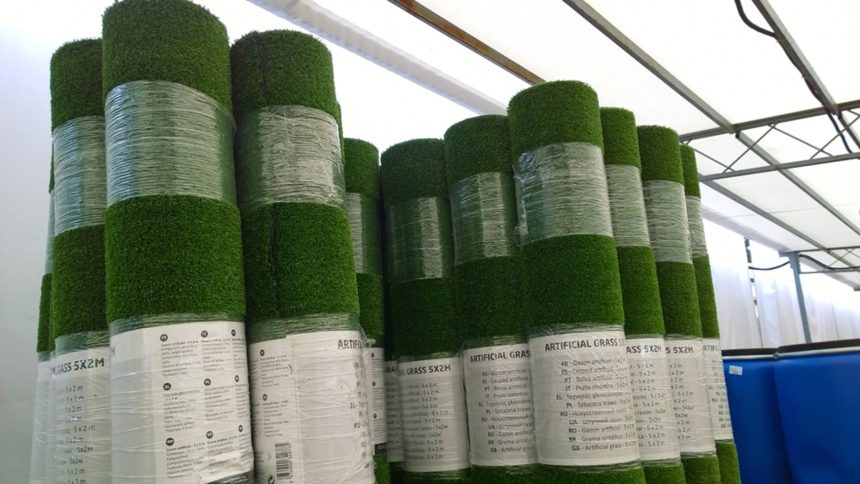Today’s modern world has artificial turf, from sports arenas to residential backyards. It seems like a great idea on the surface, offering a low-maintenance solution for areas that would traditionally use natural grass. However, it comes with some major costs to our environment and health.
Artificial turf contributes significantly to greenhouse gas emissions and generates non-biodegradable waste that can contaminate our oceans and rivers. Not to mention the potential chemical exposure, burns, and allergies experienced when exposed to these materials.
All in all, artificial grass may seem like a quick color fix, but we should be mindful of long-term consequences sure to follow!
The Need to Act
The world is quickly running out of resources for us and future generations, and it’s time to take some important measures. We can’t wait any longer. Banning synthetic grass needs to be at the top of the list! It’s an ecological disaster with chemical emissions, non-biodegradable waste, and natural resource depletion.
We owe it to ourselves and our planet’s health to put eco-friendly solutions like natural grass and native plants into action before it’s too late. Let’s take steps today so future generations can reap the rewards tomorrow. After all, there is no price too high for a healthier planet!
The Downsides of Plastic Grass
Artificial turf may seem like an excellent solution for landscaping needs and reducing the water needed for maintenance, but it has an overwhelmingly negative impact on our environment. Plastic grass creates huge waste management issues due to its non-biodegradable nature and produces microplastics that contaminate our waterways.
The carbon footprint of artificial turf production is massive, impacting local ecosystems and reducing biodiversity. Local birds, butterflies, and other wildlife see a plastic lawn, and there’s nothing there for them at all. That dramatically impacts local wildlife and even food production.
The composition of soil and water retention will also be detrimentally impacted by plastic grass. More eco-friendly garden solutions must be explored and adopted to protect our planet.
Don’t let the artificial grass fool you. It may look pristine and easy to manage, but in reality, it can pose major risks to the health of your loved ones! It’s also not as maintenance-free as sellers claim. You need to fertilize it, clean up the mold (and any pet mess that’s left on the surface), waste water to cool it down in the summer, and even vacuum up the leaves in the fall.
And fake grass is not without its health-related side effects. It contains toxins like lead, cadmium, and phthalates that can be dangerous when exposed. Not only that, but there are reports of allergic reactions, burns, slips and falls, an increase in infections due to inadequate drainage, and even a heat island effect caused by poor material choice.
It’s best to go for natural grasses and native plants for all-around protection to ensure your family’s safety and well-being.
Take Action Now
Everywhere you look, the call to take action now is louder and ever more earnest. The urgent need to protect our planet and its natural resources has never been more pressing or immediate. However, successfully achieving this goal begins with some of the smallest changes we can make in our daily habits.
By taking an active role in our communities and making decisions that prioritize green spaces and environmentally conscious alternatives, we can be a part of something bigger, creating a truly sustainable future for our planet.
Community leaders are already pioneering the way forward by limiting artificial grass usage, thereby prioritizing natural green spaces for the health and happiness of those around us. Let’s join forces, jump into action, and preserve our planet for generations to come!
Make the Switch to the Natural World
Plastic grass is an eyesore and also a burden on taxpayers and local governments due to its high maintenance and disposal costs. By banning plastic grass and investing in sustainable alternatives, we can create a greener, healthier world.
You can now experience the benefits of banning plastic grass and making the leap to natural, sustainable landscaping solutions! For starters, say goodbye to all that pesky landfill waste and hello to cleaner air. Nature works together to keep our environment healthy, translating into healthier lives for you, your family, and your pets.
Once people start embracing native plants, xeriscaping, and permeable paving within their homes, a culture of sustainability will begin to grow and expand with the help of education and engagement. Think outside the box and positively impact our planet’s future.
Eco-Washing
Don’t let big companies fool you. Plastic grass is far from being green. Factoring in all the energy and resources required for production, the diesel containers for transport, and the fuel wasted on maintenance, the true environmental impact of the plastic turf industry isn’t pretty.
And yet many companies are still actively engaging in eco-washing to make it seem like their product is saving the environment. Plastic grass further pressures our planet even more than a regular lawn, but don’t let that dampen your weekend barbecues! There are many ways to craft an eco-friendly garden without relying on a fake lawn. Onwards towards sustainability!
Let’s Ban Plastic Grass, Now
Plastic grass may look inviting and add some color to our neighborhoods, but it’s also bad news regarding the environment. Fumes from plastic turf leech toxic gasses into the atmosphere, and any excess waste quickly enters the water supply. We can do better than that!
By banning plastic grass and promoting sustainable landscaping solutions, we can revolutionize our communities and create a healthier future for everyone. Successful eco-friendly initiatives are beautiful additions to any space and clean our air and protect our wildlife from pollutants. It’s time for us to rise together in unison and demand change. Let’s ban plastic grass for good!















